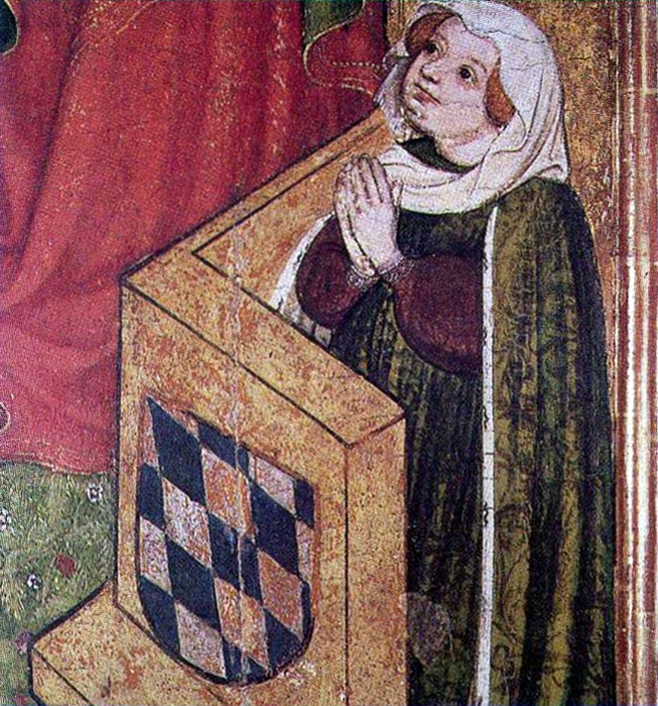1. Life and Regency
Elisabeth's life was marked by her noble birth and her significant political influence as a consort and regent, particularly in the early years of the Electorate of Brandenburg.
1.1. Early Life and Marriage
Elisabeth was born in 1383, likely at Trausnitz Castle, as the eldest daughter of Frederick "the Wise", Duke of Bavaria-Landshut, and his second wife, Maddalena Visconti. She had an older half-sister also named Elisabeth (1361-1382), who died the year before Elisabeth's birth. On 18 September 1401, she married Frederick VI of Hohenzollern, who at the time held the title of Burgrave of Nuremberg. Her husband's status was elevated on 30 April 1415 when he was appointed Elector of Brandenburg, subsequently reigning as Frederick I. The House of Hohenzollern became a significant dynasty through this lineage.
1.2. Electress Consort and Regent
As Electress consort of Brandenburg from 30 April 1415 to 20 September 1440, Elisabeth effectively managed the political affairs of Brandenburg during her husband's prolonged periods of absence. Frederick I was frequently away on military campaigns and diplomatic duties, traveling extensively to Italy, the Kingdom of Hungary, and attending significant events such as the Council of Constance. Despite the considerable political problems and challenges facing Brandenburg during this era, Elisabeth demonstrated remarkable wisdom and competence in representing her husband and administering the territory. Her capable regency was crucial in maintaining the stability and governance of the Electorate.

2. Issue
Elisabeth and Frederick I had ten children, contributing significantly to the lineage of the House of Hohenzollern:
- Elisabeth (1403-31 October 1449, Liegnitz):
- Married in Konstanz in 1418 to Duke Louis II of Brieg and Legnica (1380/5-1436).
- Remarried in 1438 to Duke Wenzel I of Teschen (1413/18-1474).
- John "the Alchemist" (1406-1465), Margrave of Brandenburg-Kulmbach.
- Married in 1416 to Princess Barbara of Saxe-Wittenberg (1405-1465).
- Cecilia (c. 1405-4 January 1449):
- Married in Berlin on 30 May 1423 to Duke William I of Brunswick-Lüneburg (1392-1482).
- Margaret (1410-27 July 1465, Landshut):
- Married in 1423 to Duke Albert V, Duke of Mecklenburg (1397-1423).
- Remarried in Ingolstadt on 20 July 1441 to Louis VIII, Duke of Bavaria (1403-1445).
- Married for a third time in 1446 to Count Martin of Waldenfels (died 1471).
- Magdalene (c. 1412-27 October 1454, Scharnebeck):
- Married in Tangermünde on 3 July 1429 to Duke Frederick of Brunswick-Lüneburg (1418-1478).
- Frederick II "Eisenzahn" (1413-1471), Elector of Brandenburg.
- Married in 1446 to Princess Catherine of Saxony (1421-1476).
- Albert III "Achilles" (1414-1486), Margrave of Brandenburg-Ansbach, Margrave of Brandenburg-Kulmbach, and Elector of Brandenburg.
- Married in 1446 to Princess Margarete of Baden (1431-1457).
- Married in 1458 to Princess Anna of Saxony (1437-1512).
- Sofie (born and died 1417).
- Dorothea (9 February 1420-19 January 1491, Rehna):
- Married in 1432 to Duke Henry IV, Duke of Mecklenburg (1417-1477).
- Frederick "the Fat" (c. 1424-6 October 1463, Tangermünde), Lord of Altmark.
- Married in 1449 to Princess Agnes of Pomerania (1436-1512).
3. Legacy
Elisabeth of Bavaria-Landshut's legacy is twofold: her significant role as an ancestress of the royal line of the House of Hohenzollern, particularly through her third son Albert III Achilles, Elector of Brandenburg, and her direct contribution to the political stability of Brandenburg. Her capable and wise regency during a critical period, managing the Electorate's affairs in her husband's long absences, ensured the continuity and development of Brandenburg. Her effective governance amidst political challenges left a lasting impact on the foundation of the burgeoning Brandenburg state.